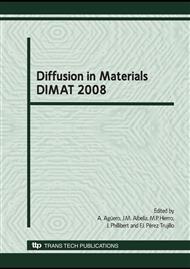p.565
p.573
p.587
p.593
p.601
p.609
p.615
p.623
p.633
Unusual Behaviour of the Dissolutions Kinetics of one Monolayer of Si in Cu(001)
Abstract:
We present an experimental study by Auger electron spectroscopy (AES) and low energy electron diffraction (LEED) of the dissolution of about one monolayer of silicon previously deposited at room temperature on Cu (001). The isochronal dissolution has been recorded in the temperature range [50-320°C] (annealing rate 1.5°C/min). The plateau observed in the kinetics dissolution for temperatures between 95°C and 240°C, reveals the formation of an intermetallic two dimensional superficial phase thermally stable in this range of temperature. On the plateau, LEED patterns show the formation of a (5x3) superstructure. Above 255°C, we observe a very fast dissolution of the surface alloy characteristic of a first-order surface transition. Isothermal dissolutions kinetics have been recorded above and under the surface transition temperature (250°C and 270°C). From these measurements, we have evaluated bulk diffusion coefficients of Si in Cu assuming a local equilibrium. The diffusion coefficients measured within this hypothesis at 250°C and 270°C are respectively higher and lower than those extrapolated from high temperature measurements for Ge in Cu.
Info:
Periodical:
Pages:
601-606
Citation:
Online since:
April 2009
Price:
Сopyright:
© 2009 Trans Tech Publications Ltd. All Rights Reserved
Share:
Citation:


